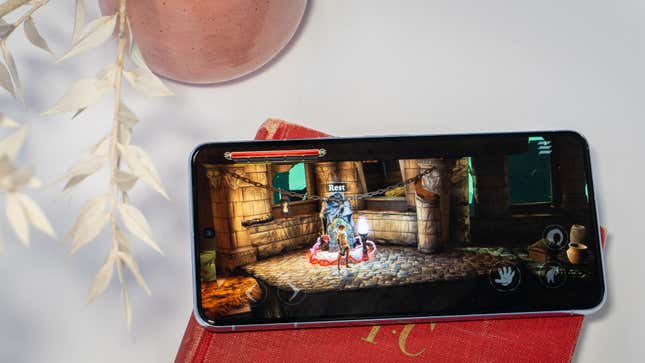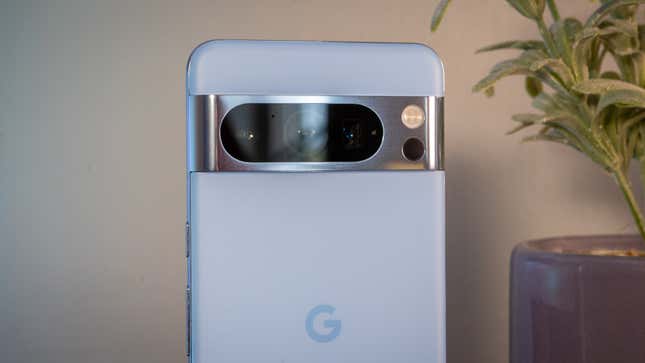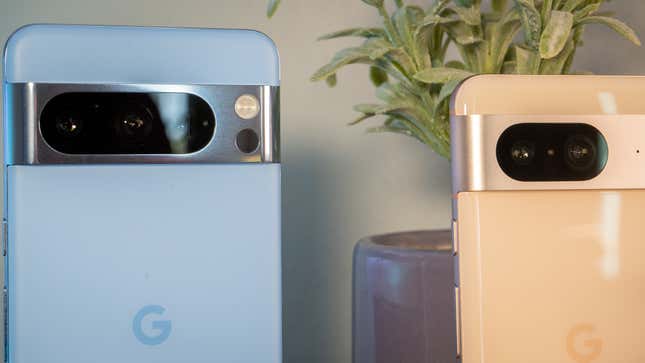Let’s set the record straight: I was too harsh on the Pixel 8 and Pixel 8 Pro in my initial hands-on. They’re not “dull” in the least bit. After more time with both devices, I’ve realized the Pixel 8 is officially the best small Android flagship you can buy, helped by Google’s renewed promise of seven years of software updates. And while the Pixel 8 Pro isn’t a giant leap forward, its small strides give us a better understanding of how Google will delineate between a Pro-level Pixel and a regular Pixel.
I’m mostly underwhelmed by all the AI-powered tricks Google talked about during its launch presentation, though I did try them out. I’m more into the fact that Google made a powerful, small little phone and a bigger one with a zoom capability that can see well into my neighbor’s window down the street. The Pixel 8 and Pixel 8 Pro aren’t the best Android phones of the year—the regular Pixel is still missing some bits I’d like to see at its $700 price point, and the zoom capability of the Pro remains rivaled by Samsung’s 100x digital zoom on the Ultra. But they are perfect examples of what Google does best. The algorithm still produces excellent photos, and they’re sharper now. Google’s promise of prolonged software updates is also great news for the rest of the Android world, as this now puts the onus on other manufacturers to follow suit with similar promises.
Pixel 8 and 8 Pro: Good looks with a better feel

The Pixel 8 and Pixel 8 Pro look different enough from last year’s Pixel 7/7 Pro that you might kick yourself for not waiting to upgrade. Well, that could be said about the Pro variant, anyway. This time, Google’s Pixel 8 Pro feels like a flagship because of its flocked matte back. It’s not as tumbled as the backside of Apple’s iPhone 15, but it feels way more premium than last year’s shiny green-gray Pixel 7 Pro. The special color for this year’s 8 Pro is a punched-up royal blue called “Bay.”
The Pixel 8 didn’t get much of that premium upgrade. Its corners are now rounded like the 8 Pro, but the back is still shiny and slippery. Oddly, Google picked a blush pink for the Pixel 8's unique colorway, considering the blue-hued motif it adopted for the rest of the Pixel and Nest home lineup over the last year. I hoped the Pixel 8 would match the blue on the Pixel 7a.

The Pixel 8 Pro’s rear-facing camera bar is now more raised from the back. Presumably, it’s because of the beefed-up camera sensors—there’s a full 50-MP primary camera, plus two 48-MP lenses with ultra-wide and telephoto capabilities. The Pro is also heftier than its predecessor by a gram, but I appreciate the added density because it feels premium in my hand. The bump is more prominent on the Pixel 8, too, though it weighs less than the Pixel 7.
The Pixel 8 and Pixel 8 Pro feature new OLED screens by Google called “Actua” displays. The Pixel 8's 6.2-inch Actua display is about a tenth smaller than last year’s Pixel 7, though it makes the Pixel 8 the best small phone I’ve held in a while—only the Samsung Galaxy S23 is a bit smaller.

The 6.7-inch Pixel 8 Pro is the one that boasts Google’s new Super Actua display, the “super” referring to the screen’s brightness capabilities. The Pixel 8 Pro can manage up to 2,400 nits of peak brightness compared to the Pixel 8's 2,000 nits. I only measured the maximum brightness of 609 nits indoors with my light meter, so you must be out in direct sunlight with adaptive brightness turned on to achieve the effect. Also, just because the display can get very bright doesn’t mean it gets just as dim. I still prefer Samsung’s Super AMOLED for nighttime browsing because of how low it goes.
There’s excellent news for those who choose the Pixel 8 for its compact size. Google has decided to grace it with a 120Hz refresh rate, so the smallest flagship is no longer limited to 90Hz. I hoped Google would do this after it increased the refresh rate on the Pixel 7a. But you won’t get that 1Hz for the always-on display, which is limited to the Pixel 8 Pro.
Google’s downplaying its new sensor but it brings the goods

Meet Google’s third-generation Tensor G3 processor, reinforced with Google’s Titan M2 security chip. Google made no wild claims about this year’s chip and its capabilities. It even admits in a blog post that its work with Tensor “has never been about speeds” or “traditional performance metrics.” If you were to go by Geekbench 6, you would think the processor isn’t up to the task—it doesn’t yet work with the benchmarking suite. But paired with 12GB of memory, the Pixel 8 Pro soars with gaming and AI-driven photo processing.
Let’s talk about gaming first since Google’s made quiet strides to remind us it still cares even though it killed off Stadia. Before sitting down to pen this review, I planned for my booster, so I used lying down as an excuse to dig into the Android gaming library for something new. I played through the first few acts of Grimvalor, a Metroidvania-like action game free for Google Play Pass subscribers. I played it with 8bitdo’s teeny-tiny Micro Controller with the Pixel 8 Pro propped up against a pillow. The graphics and gameplay were smooth the whole time. I liked switching between the touch input and the controller without missing a beat. Later, I was able to log into Dreamlight Valley to check on my crops through Android’s Xbox Game Pass beta. It took about five minutes for the game to load on the Pixel 8 Pro, but the fact that I can check into a PC-caliber game from the cloud on a smartphone will never cease to amaze me.

The photo editing features are the real reason you’d choose a Pixel smartphone over anything else, as the Tensor G3 is specially tuned for abilities like Magic Eraser and Best Take, which is the Pixel 8/8 Pro’s newest get. Best Take works a little like Top Shot in that it uses multiple exposures as a reference to help you fuse them all together into the best shot. It’s been mired in controversy as folks call it a “fake” way to capture a moment. You don’t have to use the feature if it creeps you out, and anyway, it’s buried deep in the Google Photos app if it’s something you want to use.
Admittedly, I forget these photo features are on the Pixel. Even with the Pixel 7, which I wielded for the last year, I hardly used Magic Eraser outside of showing it off for an article. But I did play around with Magic Editor. I got it to work a few times with photos I didn’t take with the Pixel 8 Pro. The feature helps make minor edits to images, like increasing a person’s size to add depth or removing an object, without making it too obvious you used a Photoshop-like tool. I used Magic Editor to edit a photo of my kid and her classmate on a field trip, taken with a OnePlus 10T and uploaded to a shared Google Photos album. But because I did the edit on the Pixel 8 Pro, I was able to remove an errant leg from the photo. For a beta feature—the Labs caveat pops up before you can use it—it’s pretty impressive. But zoom in, and you’ll notice where the AI helped out. At least it’s not a creepy edit.
Magic Editor can help in most minor situations if you have the time to tinker with an AI image editor. But don’t expect it to be magic all the time. For instance, I tried to turn that photo of my kid and her friend from a morning photo to one shot during Golden Hour, but it looked too unnatural to share.
Going with the handheld Pixel 8 will net you a smaller 4,575 mAh battery compared to the larger Pixel 8 Pro’s 5050 mAh battery pack. I am still running the complete battery tests on these particular devices, but I wonder if they’ll outpace the iPhone 15/15 Pro’s stellar battery performance in our internal benchmark charts. Google promises 24 hours of battery life. So far, the iPhone 15 Pro Max is the only one that’s lasted nearly 25 hours.
With the Pixel 8 Pro so far, I got seven hours and 31 minutes of mixed-use—everything from watching YouTube TV to installing new apps to playing games—before charging the phone at 11% in the evening. I’d had the phone on standby beforehand and started using it at 51% in the morning. I’ll have more concrete battery results for you soon.
The Pixel 8 Pro’s temperature sensor isn’t all that hot, yet
I almost forgot to include a section on the temperature sensor in the Pixel 8 Pro. That feature doesn’t come with the Pixel 8, for whatever reason, though I have contacted Google to ask why not. The Verge dug into a bit, and it’s possible a feature like this could be used for wellness tracking purposes. But this feature feels similar to the motion sensor in the Pixel 4 in that it’s only for testing purposes. We’ll see it once on the Pixel 8 Pro and never again.
Anyway, I tried the temperature sensor on a hot plate that I use to keep my coffee warm in the mornings. The Pixel 8 Pro did warn me of possible burn from the nearly 200 degrees Fahrenheit plate. I did not touch the plate. I zapped it with my kitchen thermometer, which said it was 40 degrees hotter than the Pixel 8 Pro initially measured.
The Pro version features ultra-sharp zoom capabilities

It is hard to choose the best camera among the newest Android smartphones. These days, it all comes down to color temperature preference and whether you like one camera app’s interface over another.
If you want access to the absolute bounty of Google’s photo-taking prowess, you’ll want to shell out for the pricier Pro variant. While the Pixel 8 and 8 Pro sport the improved primary 50-MP lens with an 82-degree field of view and an aperture of f/1.68, the Pixel 8 remains saddled with last year’s 12-MP ultra-wide angle lens for landscape shots. The Pixel 8 Pro gets the actual update.
The Pixel 8 Pro’s secondary camera is a 48-MP ultra-wide sensor with a 125.5-degree field of view and an f/1.95 aperture. Now, you can take those dramatic nighttime shots at a wide angle. Its tertiary telephoto lens also got a bump up to 48-MP and a 21.8-degree field of view. This sensor also offers up to 5x optical zoom, similar to the iPhone 15 Pro Max’s new offering, and digital zoom—sorry, Super Res Zoom—up to 30x.

The zoom has noticeably improved. I found it easier to snap photos from far away at dusk without losing much detail, though I did it all with help from a tripod. It was interesting to see how much detail the 8 Pro’s tiny lenses could capture from miles away, especially if you use the full 50-MP shooting ability. However, what you get in sharpness, you give up in deference to the Pixel’s way of post-processing. I don’t know if it’s the fact the weather and lighting in my area haven’t been the best, but I had hoped for a little more luster in the photos shot with the Pixel 8 Pro compared to the iPhone 15 Pro Max. I surveyed folks with the sample photos below, and a few agreed that the iPhone version appears more vibrant compared to the 8 Pro’s result. I still think the iPhone skews too yellow. Regardless, color temp is easily adjustable.

The Pixel 8 Pro has also been improved with enhancements to the camera interface, though I foresee this being a change that eventually rolls out to older Pixel hardware. Google added a “Pro” mode to the Pixel 8 Pro, so you can go in and more easily switch between JPEG and RAW files or switch between the 12-MP pixel-binning technology the Pixel typically utilizes to the full 50-MP resolution that produces photos you can edit on a desktop. I’m still uncovering how these particular features on the Pixel 8/8 Pro compare to the iPhone 15 Pro Max’s equivalent features—Apple also enabled folks to shoot at the full 48-MP resolution with its Pro phones. But for the most part, sharpness and clarity seem to be the upside to shooting this way with a smartphone. Just look at the sharpness in these shots taken with the Pixel 8 Pro in its 50-MP mode.

There is much more to explore about the Pixel 8 Pro’s camera system—more than I could have gotten to in less than a week’s worth of testing. As the photo-heavy holiday season approaches, I’ll have the Pixel 8 Pro and iPhone 15 Pro Max on hand to compare them as primary shooters. I also hope to test the 8 Pro’s Ultra HDR capabilities, though that’s only if I can come into contact with screens that can display the colors.
Before we move on, I want to point out that the Pixel’s front-facing camera is no longer the bane of my existence. I was disappointed with the Pixel 7's selfie camera performance. There were constantly times I’ve tried to take a run-and-selfie shot with a friend while whisking off to catch the last train home, only to have the photo turn out to be a blurry mess. The Pixel 8's 10.5-MP camera—bumped down from last year’s 10.8-MP—has been more consistent in the week I’ve had it than its predecessor I was using for the last year. I haven’t had to wait for the phone to take a picture.
Pixel promises seven years of updates
Android 14 is coming to all compatible devices. You’ll get the perks of the new operating system the minute you take the Pixel 8 and Pixel 8 Pro out of the box. You’ll also get Google’s renewed promise of seven years of software updates, a first for the Android platform. This includes seven years of Android version updates, Feature Drops, and security patches. It’s as good an update policy as Apple’s, inspiring other manufacturers in the ecosystem to attempt to follow suit. We shall see how this manifests a year from now.
Should you buy the Pixel 8 or 8 Pro?

Before I sat down to write this review, I traded in my Pixel 7 for the Pixel 8 at the Google store. I want a smaller size. Here’s to hoping that Google keeps beefing up this line because it’s finally as much of a package as the companion Pro offering. For a starting price of $700, you get the 50-MP camera and improved front-facing camera, the Tensor G3 with access to all the Google Photos-facilitated photo editing, a 120Hz refresh rate, and seven years of updates. The only bummer is that the Pixel 8 maxes out at 256GB of storage, which seems silly since it can shoot in RAW like the 8 Pro.
Google’s $1000 Pixel 8 Pro finally feels on par with the iPhone 15 Pro Max in terms of pro-level offerings. There are pro-level controls for the cameras, a periscopic telephoto lens that can see about a mile away, and the device is finally available with up to 1TB of storage. Google is getting better with the looks, too, and the more matte it makes the backside of the Pixel, the happier I am to not have a phone slip out of my periphery. The 8 Pro isn’t an essential update, though it does spell good news for what’s ahead from Google’s Pro line.
While the Pixel 8/8 Pro’s machine learning and AI powers are nice to have, remember they’re often backward compatible. Unless you’re on a Pixel 5, which ceases to receive software updates as of this year, there’s no need to upgrade.
